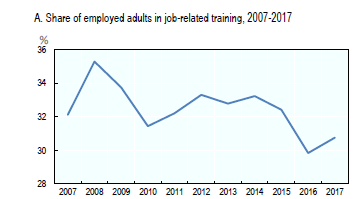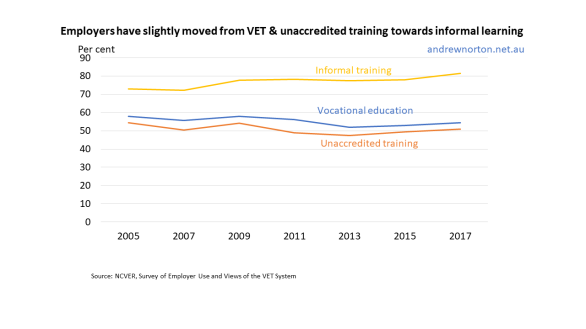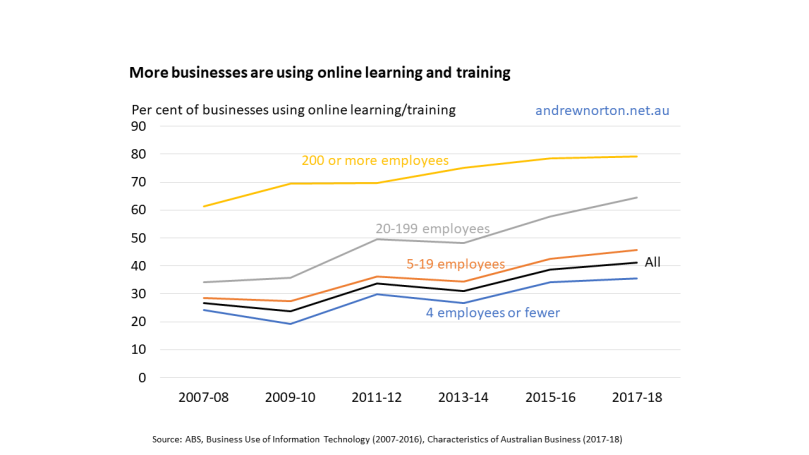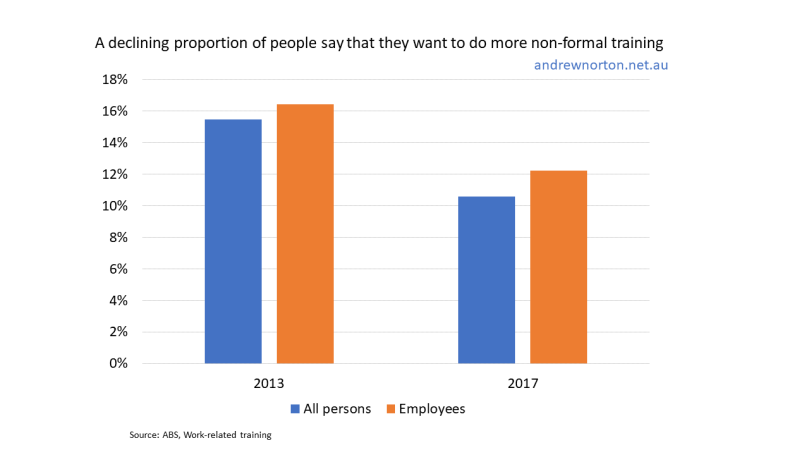In August, although I only noticed it yesterday, the OECD published a report on work-related training in Australia relevant to my recent blog posts. It has a couple of data sources I had missed that confirm the declining use of some forms of training.
The HILDA survey has a question about whether employed respondents have undertaken any education or training. Based on the questionnaire, it could have been higher education, vocational education or unaccredited training but it has to be ‘structured’. So it would not include short online self-education.
As the chart below from the OECD report shows, the proportion of workers undertaking any type of training has declined. From peak to trough, the proportion participating in structured learning for work over the previous 12 months has declined by about 5 percentage points.

I don’t have access to HILDA data, but it has several questions related to the purpose of the training that could help us understand what is going on (recalling that NCVER data suggests that training for the respondent’s current job is declining more than for a new job or promotion).
The NCVER has an employer survey which does not ask about higher education but does include vocational education, unaccredited training and ‘informal training’. The latter is defined as ‘training that usually occurs on-the-job through interactions with co-workers as part of the day-to-day work’. This would not capture staff teaching themselves, but the fact that it has been the most common form of training since the survey began (chart below) highlights the importance of learning outside the formal training and education system.
Although there are no dramatic short-term trends, over a decade the proportion of employers using informal training has gone up while the proportion using vocational education or unaccredited training has gone down.

The ABS has surveys of business use of the internet for ‘online learning/training’ (type not otherwise specified). Unsurprisingly, this has grown over time (chart below). Big business has made extensive use of it at least since 2007-08, but more recently there has been rapid take-up in medium size businesses (20-199 employees).

One interesting question is the timing of change. Higher education and vocational education enrolment data suggest some recent movements, and for mid-size and smaller businesses there has been a surge in online training over the last five or so years.
But HILDA, the employer survey, the ABS work-related training survey and ATO self-education claims suggest a significant shift in training practices happened about a decade ago. I am not sure whether this lines up with increased availability of online self-education sites or not.
The OECD report thinks that the decline it observes in structured training in Australia is a problem, pointing to changes in the labour market that would require re-skilling or retraining. Certainly there are people who would like to do more training. But they are a shrinking proportion of the population and workforce (chart below).

It seems unlikely that the total demand for training could have fallen so much (lower participation + lower unmet demand). Even if growth in the need for reskilling has been exaggerated, I can’t see what labour market changes would have triggered a substantial reduction in training requirements. It seems more likely that education and training is taking a different form – whether online self-education or the peer learning in the employer survey – than it is that education and training is in decline.